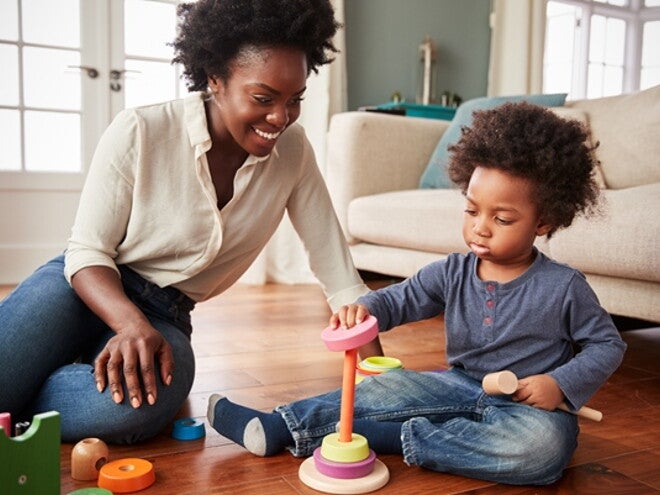
66 months Milestone
Your child now understands and uses a wide variety of words that indicate position and shape such as above, below, next to/beside, on top of, near, at the bottom, behind, around, away from, between, first, last, in a line, in front, at the back, middle, in a corner, circle, square, rectangle, triangle and rhombus (diamond).
According to early mathematics expert Douglas Clement, it is important for adults to use these words in everyday conversations. We should say things like, “Look, I cut your sandwich into triangles,” and “Let’s put a raisin in the middle of every cookie.” This is a sure way to “mathematise” your child.
Clement says that all young children have the same implicit (understood but not stated) understanding of mathematics. However, this understanding does not become explicit (clearly stated) if a child doesn’t learn to understand and use the words that give life to it.
We learn 20 % of what we hear, but 70 % of what we discuss
Children learn more from reading books when they are encouraged to have a conversation (dialogue) with the person who is reading the book. This is known as dialogic reading.
Nobody learns to play tennis by watching someone play. Similarly, children’s language skills develop with practice. Dialogic reading is an interactive and engaging way to read a book with a child where they get the opportunity to talk about the story, use new words and practice their language skills. Before long, your child will do most of the talking while you read. That’s when you know you’re doing it right!
Reading experts advise parents and educators to use the PEER sequence to guide them and make it easy to have a short interaction on just about every page.
P: (Prompt) Ask a question. The easiest questions to ask are ones that start with who, what, where, why and when because they have a way of encouraging a child to repeat words that you have just read. For example. “What kind of animal is this, can you remember?” or “Why was Little Red Riding Hood going into the woods?”
E: (Evaluate) React to whatever your child says in response. It usually suffices to simply say, “Yes!”
E: (Expand) Elaborate with a little more information. It works well if you simply rephrase what your child said and add a little bit of extra information if needed.
R: (Repeat) Repeat your original question. The idea is to steer your child’s attention back to what’s happening in the story at that point. Then turn the page.
Here’s an example:
Point to the illustration and ask (prompt): “Can you remember why Little Red Riding Hood was going into the woods?” Your child answers: “She’s on her way to her grandmother to take her some food. It’s in that basket.”
You respond (evaluate) by saying, “Yes!”
Then elaborate (expand): “Little Red Riding Hood is on her way to her grandmother to take her a special treat because she is desperately ill in bed. Her mommy packed it into this beautiful woven basket.” You can ask more questions as your child’s concentration span increases.
Lastly, return to the basic story (repeat): “Where is she going? She’s on her way to her grandmother. Now, let’s see what happens next.”
Researchers say that children, whose parents and caregivers read to them in this way, fare better in tests of language development compared to children who simply sit and listen. In fact, children can jump ahead by several months in just a few weeks of dialogic reading.
Tip: Be a reading and writing role model
Even though you may prefer using your phone, be a good role model and let your child see you use a pen to write words down on paper when you put your shopping list together.
You can also, from time to time, focus your child’s attention on the printed words when you are reading a book together. Move your finger from left to right as you read and point out individual letters and words to tell your child what they mean.
This is an effective way of introducing children to the mechanism behind reading. Specifically that letters represent speech sounds, that they are grouped to form words, which are strung together from left to right to create sentences.